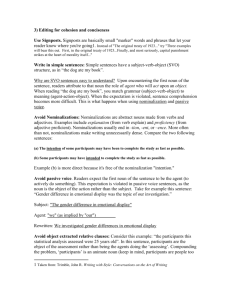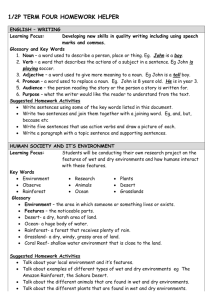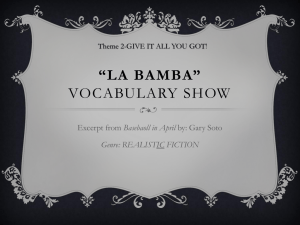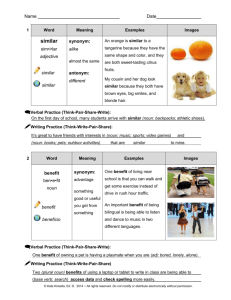Teaching and Learning Sequence
advertisement
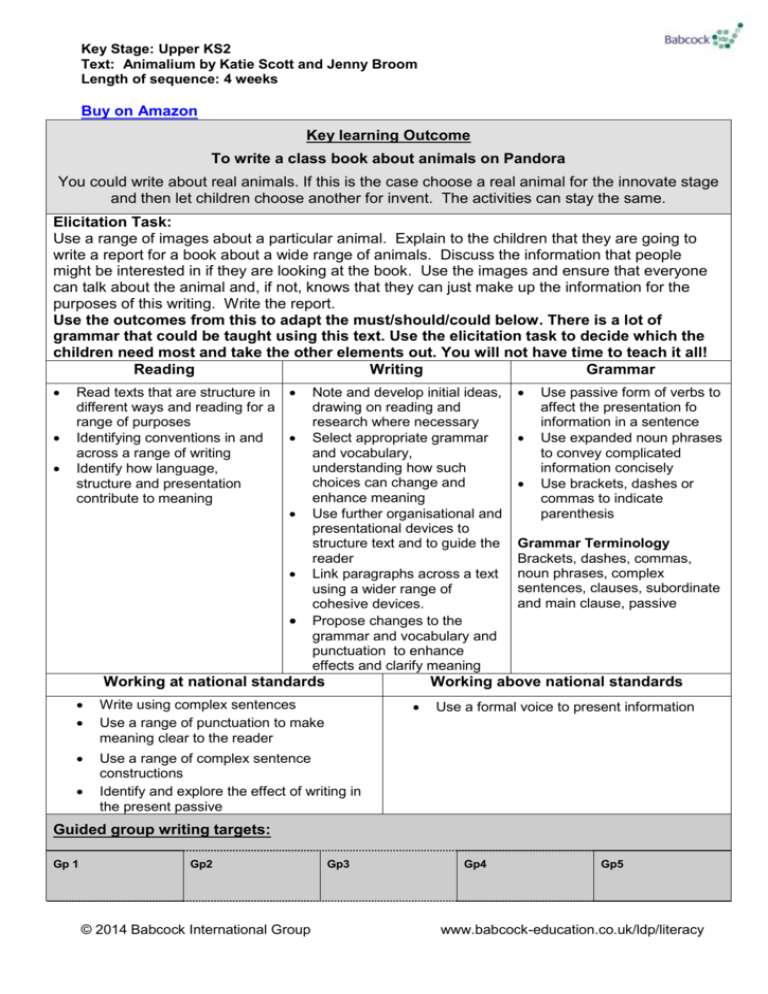
Key Stage: Upper KS2 Text: Animalium by Katie Scott and Jenny Broom Length of sequence: 4 weeks Buy on Amazon Key learning Outcome To write a class book about animals on Pandora You could write about real animals. If this is the case choose a real animal for the innovate stage and then let children choose another for invent. The activities can stay the same. Elicitation Task: Use a range of images about a particular animal. Explain to the children that they are going to write a report for a book about a wide range of animals. Discuss the information that people might be interested in if they are looking at the book. Use the images and ensure that everyone can talk about the animal and, if not, knows that they can just make up the information for the purposes of this writing. Write the report. Use the outcomes from this to adapt the must/should/could below. There is a lot of grammar that could be taught using this text. Use the elicitation task to decide which the children need most and take the other elements out. You will not have time to teach it all! Reading Writing Grammar Read texts that are structure in different ways and reading for a range of purposes Identifying conventions in and across a range of writing Identify how language, structure and presentation contribute to meaning Note and develop initial ideas, drawing on reading and research where necessary Select appropriate grammar and vocabulary, understanding how such choices can change and enhance meaning Use further organisational and presentational devices to structure text and to guide the reader Link paragraphs across a text using a wider range of cohesive devices. Propose changes to the grammar and vocabulary and punctuation to enhance effects and clarify meaning Working at national standards Use passive form of verbs to affect the presentation fo information in a sentence Use expanded noun phrases to convey complicated information concisely Use brackets, dashes or commas to indicate parenthesis Grammar Terminology Brackets, dashes, commas, noun phrases, complex sentences, clauses, subordinate and main clause, passive Working above national standards Write using complex sentences Use a range of punctuation to make meaning clear to the reader Use a range of complex sentence constructions Identify and explore the effect of writing in the present passive Use a formal voice to present information Guided group writing targets: Gp 1 Gp2 © 2014 Babcock International Group Gp3 Gp4 Gp5 www.babcock-education.co.uk/ldp/literacy Key Stage: Upper KS2 Text: Animalium by Katie Scott and Jenny Broom Length of sequence: 4 weeks Teaching Guided Work linked to sequence Learning (I can … / I know… / I understand…) Familiarisation/ Immersion in text/Analysis Create a writerly knowledge chart with the children as you work through the imitate stage of the sequence. Imitate Explore and respond to the book prior to starting this sequence, studying pages that the children are particularly interested in. Choose an animal and a habitat that the children are interested in and learn and remember them using a map and actions. E.g. snakes and deserts. Create a likes/dislikes/patterns and puzzles chart for the pages. Discuss aspects identified by the children and choose a couple of points to follow-up on. Give pairs of children different pages from the book to explore and investigate, e.g. do all pages have three paragraphs? Are these paragraphs the same on each page? Use a photocopy of the image and label one of the snakes with the information in the general text. Put children into pairs and explain that they are scientists who are going to speak to some younger children about the animal on the page they have been studying. Prepare a talk using the information and images in the book and then go and share it with younger children. How do the pages work? Explore the structure and information on the pages. Are there any patterns in how the information is presented? Annotate pages and compare with others. As a class, create templates for the pages. Grammar (Remember you need to choose which of these activities you are going to do. (You cannot do them all!) o How is so much information shared in so few words? Go back to labels on diagrams. What sort of information did you put as labels (can you name it)? Explore the use of noun phrases, identifying those used, writing them out on strips of paper and identifying patterns. Is it the same on the habitat page? Map onto a noun phrase chart. (see below) o Use images of other animals from the book and label them using a range of noun phrases as identified above. o Explore the difference between active and passive sentences by looking at the subject and whether they are doing the verb or not. Perform a series of actions and ask children to write a sentence to describe the action as an active and a passive sentence, e.g. Joy threw the keys on the floor. The keys were thrown on the floor. Look through the text and identify the passive verbs. What effect do they have on the text? Try rewriting the sentences to make them active and reflect on the difference. o Use an image and ask children to write a short paragraph about it only using active sentences. Then repeat using the passive. What effect does writing in the active or passive have? o Look closely at the sentence with dashes and read it in the way you think the reader wants you to. Change the punctuation in it to commas and also brackets. Read these sentences and discuss the differences. Why do you think the author used dashes here? Do they use them anywhere else? Is it for the same © 2014 Babcock International Group www.babcock-education.co.uk/ldp/literacy Key Stage: Upper KS2 Text: Animalium by Katie Scott and Jenny Broom Length of sequence: 4 weeks reason? Use the sentence and create your own based on its structure, e.g. Classrooms have colourful – and pleasing – display boards, and use these to share great work by children. This type of sentence forces children to write generically which is important for this writing. o Choose some of the complex sentences from the text. Record on strips of paper. Children cut up strips into clauses and underline verbs. Investigate the order of clauses and explain why they think the author has used the order that they did. Create their own sentences using the structures to write about something else. Record them, ensuring the correct punctuation is used. Cut out the paragraphs on the snake and desert page. For each paragraph cut off the first sentence. Write these out on a sheet of paper. Model reading a paragraph and matching it up to its first sentence. What clues are you looking for? Children do this for the rest of the paragraphs. How do the first sentences link to the rest of the paragraph? . Box up the text for the animal and the habitat. Model doing this for the animal and let the children complete the habitat page. Innovate In art, create an alternative environment and design an animal that lives in it. Discuss the adaptations that the animal needs to live in this setting. Ask the children to create their own animals that have the same sort of adaptations Talk to a partner about how it is adapted to live in that environment. This would also link to science work about adaptation. Create the environment as a display either 2d or 3d so that everyone can see it. For the animals and setting, create noun phrase charts by describing what they can see and recording the words in the chart. Children can also magpie words from the text to use in the chart. Take words from the columns to put together to create a noun phrase. Box up new information adding the amount of detail needed. Go back to the map and retell the text now using the new information. Make changes where necessary. Pick a small part of this new text, retell it and then write it. Evaluate the effectiveness of the sentences. Are you using patterns that convey lots of information generically? Identify complex sentences and consider the order of the clauses used. Shared Writing Model writing the habitat and the animal information over a couple of days focusing on the elements included in the writerly knowledge chart. Children to write their own version for the habitat and animal. Evaluate the effectiveness of the writing; think about it being generic and information dense. Mark the writing and identify elements to be taught in the invent stage. Capturing Ideas Invent Watch the Pandora Discovered by downloading it from YouTube. Look closely and listen to information about the planet and make notes. Turn your classroom into Pandora. Create a noun phrase chart for children to use. Use several images from the film (google has lots). In pairs choose an image and describe it as clearly as possible. List words used © 2014 Babcock International Group . www.babcock-education.co.uk/ldp/literacy Key Stage: Upper KS2 Text: Animalium by Katie Scott and Jenny Broom Length of sequence: 4 weeks and then add them to a noun phrase chart. Create the best noun phrases you can to describe the image and label them. Go to boxing up chart and complete that part of the information. Watch video again but this time focus on the animals, making notes about what is special about them. Go back to boxing up chart and put in information that you have found out. What do you still need to know? If you can’t find that information, make it up and complete the boxing up chart. Look at the information that you have. How would you group your information and what would your topic sentence be? Create one paragraph into text orally and then write it. Ensure that you are using complex sentences and noun phrases to give lots of information. Retell the text, either the habitat or the animals one. Listen to children telling the text and ensure that they have a range of complex sentences and are generic. Teach the element identified from the innovate stage. Children write their habitat and animal page. They can use this site http://www.pandorapedia.com/ to create the animal fact files. Support children writing the text through revising and editing of the text to include the elements taught throughout the sequence. Present pages as a final, published version. Compare and comment on the progress made from the elicitation task and the invent writing Noun phrase charts Determiners Adverbs Adjectives Nouns Head noun preposition An Few A their Extremely constantly Dry Changing Passing Long Tube-like Narrow Flexible Large Forked body Climate Plants Landscape Victim Bodies Shape Backbone Jaws Tongues method Of attack Adjectives Nouns Determiners Adverbs a, an, the this, that, these, those, some, any, my, our, slightly very extremely rather quite © 2014 Babcock International Group Head noun Relative pronoun preposition of with Relative pronoun www.babcock-education.co.uk/ldp/literacy Key Stage: Upper KS2 Text: Animalium by Katie Scott and Jenny Broom Length of sequence: 4 weeks his, their, several, few, last, next, first, seventh, six, twelve who which that Boxing up Imitate Animal What does the snake look like? What is the same for all snakes? How do they track and kill their prey? Individual snakes Name Latin name Length Habitat Special features Habitat What is a desert like by day and night? The effects of temperature change How are animals adapted to this environment Innovate Invent Medium Term Plan (core objectives from POS) Reading Writing Read texts that are structure in different ways and reading for a range of purposes Identifying conventions in and across a range of writing Identify how language, structure and presentation contribute to meaning Note and develop initial ideas, drawing on reading and research where necessary Select appropriate grammar and vocabulary, understanding how such choices can change and enhance meaning Use further organisational and presentational devices to structure text and to guide the reader Propose changes to the grammar and vocabulary and punctuation to enhance effects and clarify meaning Links to Grammar and Punctuation Appendix Use passive form of verbs to affect the presentation fo information in a sentence Use expanded noun phrases to convey complicated information concisely Use brackets, dashes or commas to indicate parenthesis Grammar Terminology Brackets, dashes, commas, noun phrases, complex sentences, clauses, subordinate and main clause, passive Spoken Language © 2014 Babcock International Group www.babcock-education.co.uk/ldp/literacy Key Stage: Upper KS2 Text: Animalium by Katie Scott and Jenny Broom Length of sequence: 4 weeks Give well-structured descriptions and explanations for different purposes Simple present have are possess swallow Present participle killing not chewing coiling Present Infinitive passive are to eat characterised to death are believed are stacked are designed I © 2014 Babcock International Group www.babcock-education.co.uk/ldp/literacy
